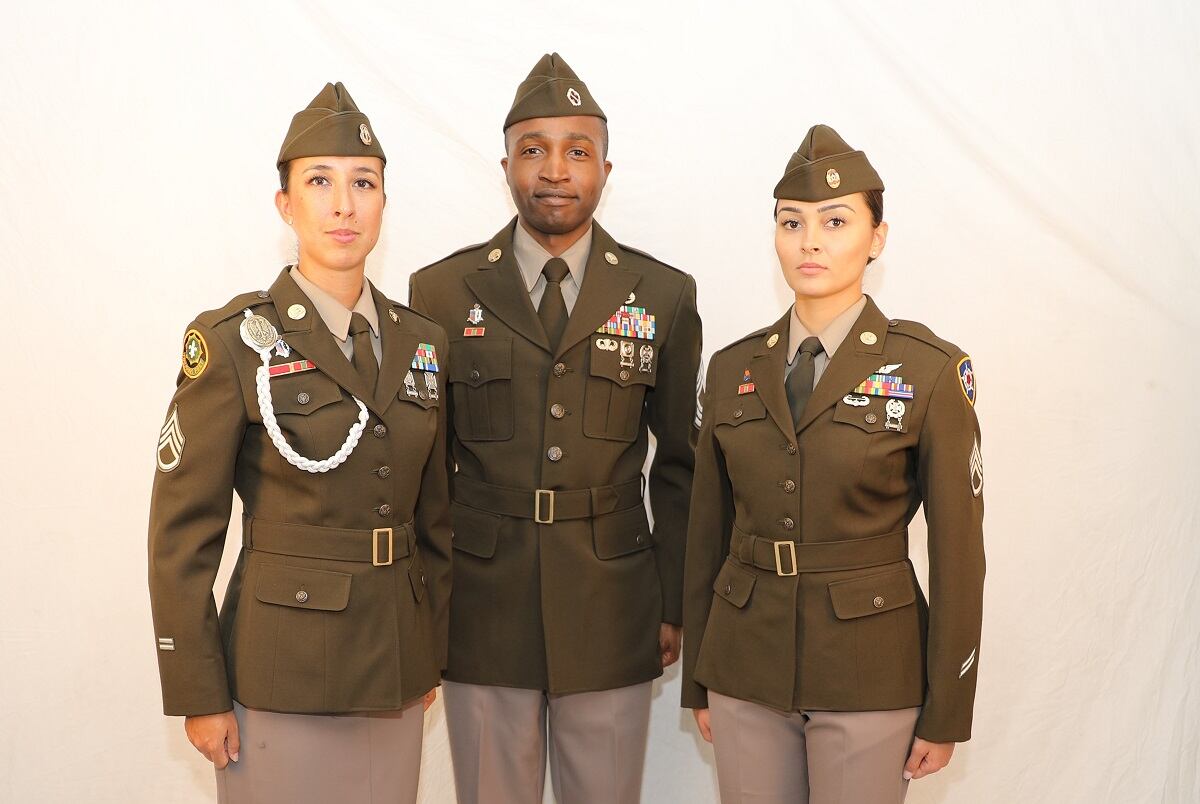A week after the Army secretary signed off on a new service uniform, final details are still being worked out as the service prepares to solicit a contract and begin fielding the throwback uniform next year.
Beyond the iconic green “Marshall” jacket, taupe pants and brown leather oxfords, soldiers will have three options for jackets, two for matching covers, and ― for airborne units ― the uniform team is working on a prototype of brown jump boots, Sergeant Major of the Army Dan Dailey told reporters on Monday.
The uniform is a nod to the World War II-era “Greatest Generation,” a nostalgic look that still resonates with Americans, Dailey said, but,"there’s another great generation that’s serving today, and those are the soldiers in the United States Army."
Photos of the most up-to-date design choices aren’t available yet, according to Col. Stephen Thomas, PEO Soldier’s protection and individual equipment program manager, because changes were being made until nearly the last minute.
The shiny gold buckles on the prototype will be replaced with a more burnished finish to match the buttons. And the lapels on the men’s jacket will be slightly shortened, Dailey added, to keep them from curling up at the ends.

Soldiers have until 2028 to pick up the new uniform, and it won’t be issued to new soldiers until 2020, but here’s what we do know:
- The foldable garrison cap ― a version of which is worn by the Navy, Marine Corps and Air Force ― will be the standard issue cover for the uniform. A circular service cap will be optional and worn according to commander guidance. The beret will also be authorized per individual commanders.
- A long, trench-style green coat will be the standard issued outerwear.
- There are three optional jackets: A “tanker” in the newly coined “heritage green” color, which is identical to the black jacket worn with Army Service Uniform class B’s: the wool “Ike jacket," a cropped green design; and a brown leather “bomber jacket,” with gathered knit cuffs and waistband, though with no shearling trim.
- The jacket and pants are a 55/45 polyester/wool, elastique blend. The short- and long-sleeved shirts are a 75/25 cotton/polyester blend.
- A pair of brown boots for airborne units to blouse their pants into are not a reality yet, but the intent is to show a design to Army Chief of Staff Gen. Mark Milley soon, Dailey said.
Now that the new uniform is approved, leadership is working on new regulations to bring it into the fold.
Because the Army Service Uniform will become the dress uniform and the Greens will become the service uniform, soldiers can expect a new name for the ASU ― probably something along the lines of “Army dress blues uniform,” Dailey said.
It’s also a possible that the Greens will be a garrison uniform for some, particularly those who work in an office environment.
“I know there was some discussion online about wearing Greens in the motor pools, and that’s not going to happen,” Dailey said.
RELATED

The first groups to wear the uniform will be “forward-facing” soldiers like recruiters, Thomas said. And for next year, his team is working on getting 500 sets made for a June event, around the time of the D-Day anniversary and the Army birthday.
‘Cost-neutral’
Leaders have so far declined to say how much the Army Greens will cost per set, only reiterating that the overall fielding of the uniform won’t cost any more than what the service is spending for ASUs now.
The higher-quality fabrics do translate to a more expensive uniform ― the ASU costs about $400 ― but some of that is mitigated by a longer wear-out period. Six years for the coat versus the ASU’s four years.
The Army is also trying to level out the budget by issuing the uniform later.
“The only purpose we issue the dress uniform at basic training is for the graduation at the end,” Dailey said.
Soldiers right now are fitted for their formal attire in the first week of basic. The Army will have to trash that uniform if they drop out of training, or it might need to be tailored again if a soldier loses or gains weight in those first months.
Around 110,000 soldiers report for basic training every year, Thomas said, and probably 6,000 of those will go home before they head to advanced individual training.
“By the time they go from AIT to their first unit, that number drops down to about 94,000,” he said.
Final cost and issuing are still being worked out, Dailey said, but soldiers can expect to see him in his at the Army-Navy game in December.
Meghann Myers is the Pentagon bureau chief at Military Times. She covers operations, policy, personnel, leadership and other issues affecting service members.




